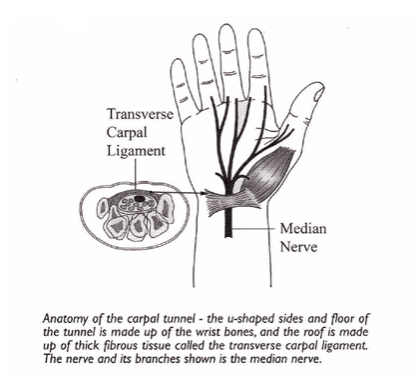This article has been verified medically by Dr Tan Ter Chyan, hand surgeon at Hand Surgery Associates, Mount Elizabeth Novena Specialist Centre (Singapore).
About the Doctor
Although carpal tunnel syndrome affects only about 1 per cent of the population, it’s one of the most common nerve compression issues and well-known enough that you’ve probably heard about it. If you’re experiencing numbness, pain and weakness in your hands and fingers, you may even wonder if you have it.
What causes carpal tunnel syndrome?
A mass of ligaments and bones in your wrist’s narrow carpal tunnel passage helps to protect the tendons and a main nerve passing through. However, when the tendons surrounding the nerve get inflamed and swell up, they may pinch the nerve, causing pain, tingling, numbness, and weakness. Symptoms may worsen without treatment.

Tendons squeezing on a nerve that passes through your wrist’s carpal tunnel gives rise to the condition. This leads to the nerve being entrapped.
Image: Hand Surgery Associates
According to information from the Singapore General Hospital, women and the elderly tend to be more susceptible to the condition. Those who hold jobs that involve wrist extension, vibration, cool temperatures, and forceful motions—such as furniture craftsmen, mechanics, those who work in garment or construction industries—may also be more vulnerable to getting carpal tunnel syndrome. To mitigate risks while working, it is important to ensure ergonomic positioning as well as prevent repetitive movements and extreme flexion or extension.
During pregnancy, women may experience some effects of carpal tunnel syndrome as blood volume and fluid retention increases, but the symptoms should subside after birth.
Symptoms of carpal tunnel syndrome
Carpal tunnel syndrome tends to occur in both hands, with symptoms felt more prominently in the thumb and first two-and-a-half fingers. Early symptoms include persistent numbness in fingers. The discomfort may also reduce dexterity and wake a patient up at night, compelling him or her to shake out their hands to ease the numbness.
As the condition progresses, patients may experience constant numbness and paraesthesia (tingling or prickling sensations) even during the day. Additionally, they may find themselves having difficulty grasping, holding onto small things or experiencing more frequent muscle cramps and pain.
Diagnosing the problem
In some cases, there may be no clear cause that gives rise to carpal tunnel syndrome. However, risk factors may include a previous fracture and medical and inflammatory conditions such as Type 2 diabetes, hypothyroidism and rheumatoid arthritis. Family history, obesity and age and being female can also contribute to the problem.
In addition to reviewing these factors, the doctor may choose to do a nerve conduction test to back up the clinical diagnosis and rule out other conditions if the signs and symptoms are not classical.
Treatment options
In minor cases or if the condition is caught early, a change of habits or occupational therapy could be sufficient. Soaking wrists in an ice bath, taking over-the-counter painkillers or wrist splinting may also help. Alternatively, your doctor may recommend corticosteroid injections. These tend to work for a short period only and are not permanent solutions.
If symptoms persist or worsen, surgery (endoscopic or mini open) may be required to reduce compression or free the nerve. Post-surgery, the soreness and weakness caused by carpal tunnel syndrome should ease within a few weeks, or up to a few months for more serious cases.












